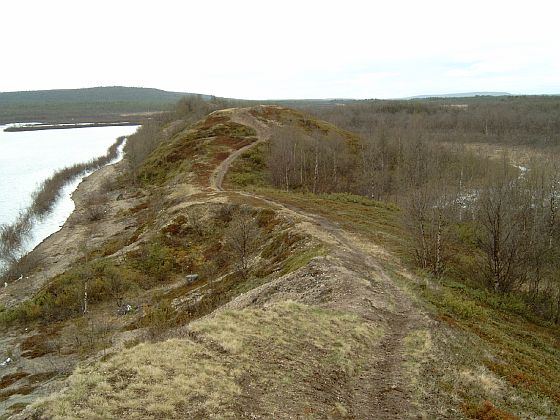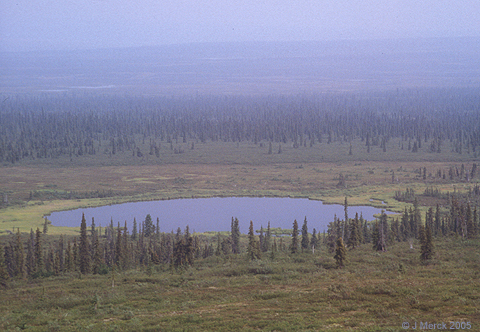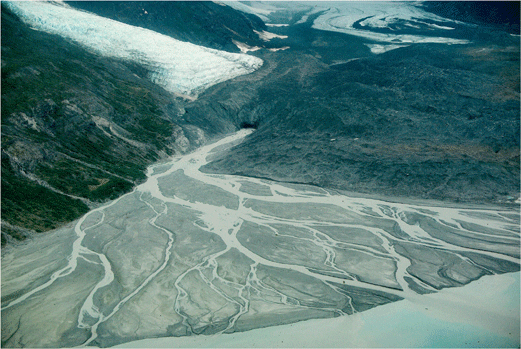
Till: Unsorted glacial sediment that is deposited directly beside the glacier. It can vary from clay, to a mixture of clay, sand, gravel, and boulders. Deposited at the terminal moraine, along the lateral and medial moraines, and in the ground moraine of a glacier.
Cirque: An amphitheatre like valley head, formed at the head of a valley glacier by erosion. It is a concave shape open on the downhill side with steep cliff like slopes on either side where ice and glaciated debris combine and converge. A notable cirque in northern america would be the cirque tower in wyoming.
Arete: A thin almost knife life ridge that is formed when two glaciers erode parallel u-shaped valleys. The arete is what separates these two valleys. An example of this in North America would be Clouds Rest in California.
Medial Moraine: Accumulation of glacial debris that runs down the centre of a valley floor. It is formed when two glaciers meet and the debris on the edges of the valley sides join and are carried on top of the enlarged glacier. Canada has a medial moraine that is 1 km in size that is in Kluane National Park. 
Lateral Moraine: Parallel ridges of debris that are deposited along the sides of glaciers. Because of the fact that they are deposited on top of glaciers they rarely erode and remain as high ridges.

Terminal Moraine: Ridges of debris that are deposited at the end of a glacier. The glacier acts much like a conveyor belt and carries the debris from the top to the bottom.

Hanging Valley: A tributary valley with the floor at a higher relief than the main channel into which it flows. They are commonly associated with a tributary glacier flowing into a glacier of a larger volume.
Crevasses: A crack in an ice sheet or glacier that. They often have vertical or near vertical walls.
Glacial Movement: The motion of glaciers that is similar to that of rivers of ice. This has played an important role in forming many landscapes. This movement can be fast up to 30m/day or only 0.5m/year. All of this motion is caused by gravity.
Receding Glaciers: Many of the glaciers that we know today are receding due to the climate change and melting of them. An excellent example of this here in British Colombia would be The Columbia Ice field. The amount of snow that falls each year is not enough to make up for the amount of snow that is melting each year.
Stationary Glacier: A glacier which has an accumulated snowfall that is equal to the melting of the previous snows. Though it says they are stationary it does not refer to the fact that they are not in motion, but the fact that they are not decreasing in size.

 Drumlin: A whale shaped hill that has been formed by glacial ice acting on underlying till or ground moraine. Its long axis is parallel to the ice with the more blunt end facing the glacial movement.
Drumlin: A whale shaped hill that has been formed by glacial ice acting on underlying till or ground moraine. Its long axis is parallel to the ice with the more blunt end facing the glacial movement. Esker: A long, winding ridge of gravel and sand which occur often in North America and Europe. Formed in ice wall tunnels by streams that flow under glaciers. They may also form above glaciers when sediment settles in crevices.
Esker: A long, winding ridge of gravel and sand which occur often in North America and Europe. Formed in ice wall tunnels by streams that flow under glaciers. They may also form above glaciers when sediment settles in crevices. Kettle Lake: Shallow, sediment filled body of water that has been formed by retreating glaciers or draining floodwater. An example of this is Lake Wilcox in Ontario.
Kettle Lake: Shallow, sediment filled body of water that has been formed by retreating glaciers or draining floodwater. An example of this is Lake Wilcox in Ontario. Outwash Plain: A plain formed of sediments deposited by the meltwaters at the end of a glacier. They are most common in Iceland.
Outwash Plain: A plain formed of sediments deposited by the meltwaters at the end of a glacier. They are most common in Iceland.





